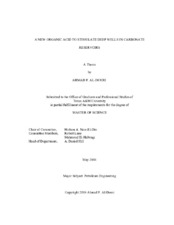| dc.description.abstract | Carbonate acidizing has been carried out using HCl-based stimulation fluids for decades. However, at high temperatures, HCl does not produce acceptable results because of its fast reaction, acid penetration, and hence surface dissolution, and its high corrosion rate. As a result, alternatives to HCl have been investigated including organic acids. In this work, the reaction of a new organic acid with calcite was investigated using the rotating disk apparatus and coreflood setup. The organic acid was obtained using both a phosphorous-based and iron-based catalyst.
The rate of reaction of a 10 wt% solution of the new organic acid was measured using the rotating disk apparatus at temperatures up to 250°F. Low-permeability Indiana limestone (1-5 md) samples of 1.5 in. diameter and 0.75 in. length were used. The effect of disk rotational speed (100-1,500 rpm) was investigated. Samples of the reacted fluid were collected periodically and calcium and iron concentrations were measured using Inductively-Coupled Plasma, and used to determine the acid-rock reaction rate and to study the possibility of precipitation. Also, coreflood experiments at different injection rates and a temperature of 300°F were performed to study the effect of the acid on
wormhole propagation in calcite. Low-permeability Indiana limestone (1-10 md) cores used in these experiments have a diameter of 1.5-in. and a length of 6 in.
For the phosphorus-based acid, experimental results showed that the rate of calcite dissolution at 205°F was controlled only by the rate of mass transfer of the acid to the surface. However, at 250°F, the reaction was controlled by both mass transfer and by the kinetics of the surface reaction. At 205°F, the reaction rate varied from 7.79E-07 to 4.47E-06 gmol/cm^(2).s, while at 250°F, the range was between 5.82E-07 and 2.72E-06 gmol/cm^(2).s. In coreflood experiments, the phosphorus-based acid caused calcium phosphate precipitation at 300°F, while the iron-based acid achieved breakthrough. Also, the optimum injection rate of the iron-based acid was determined to be 2.0 cm^(3)/min. This study summarizes the results obtained and recommends the use of the new organic acid for field applications in calcite reservoirs. | en |


